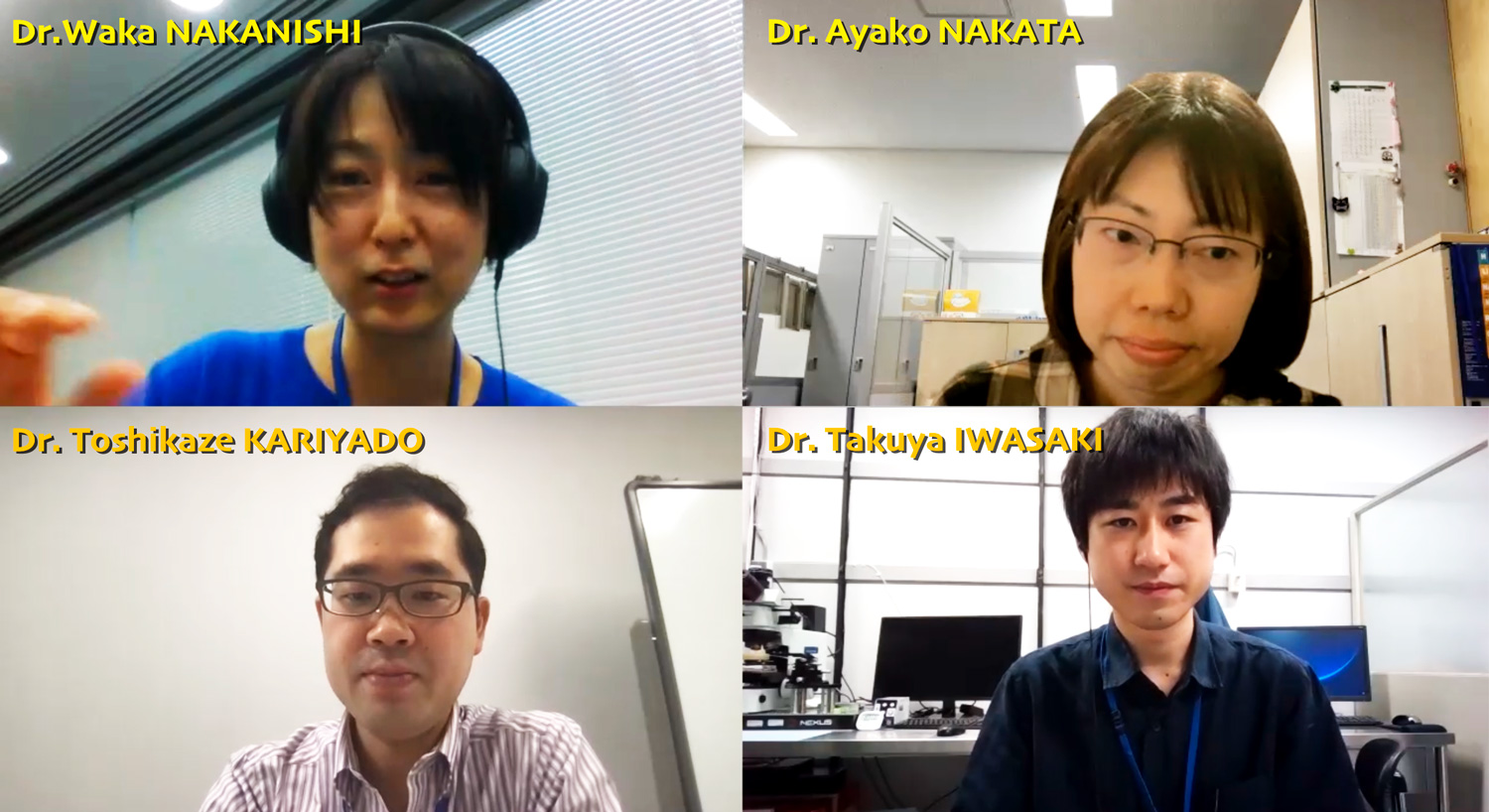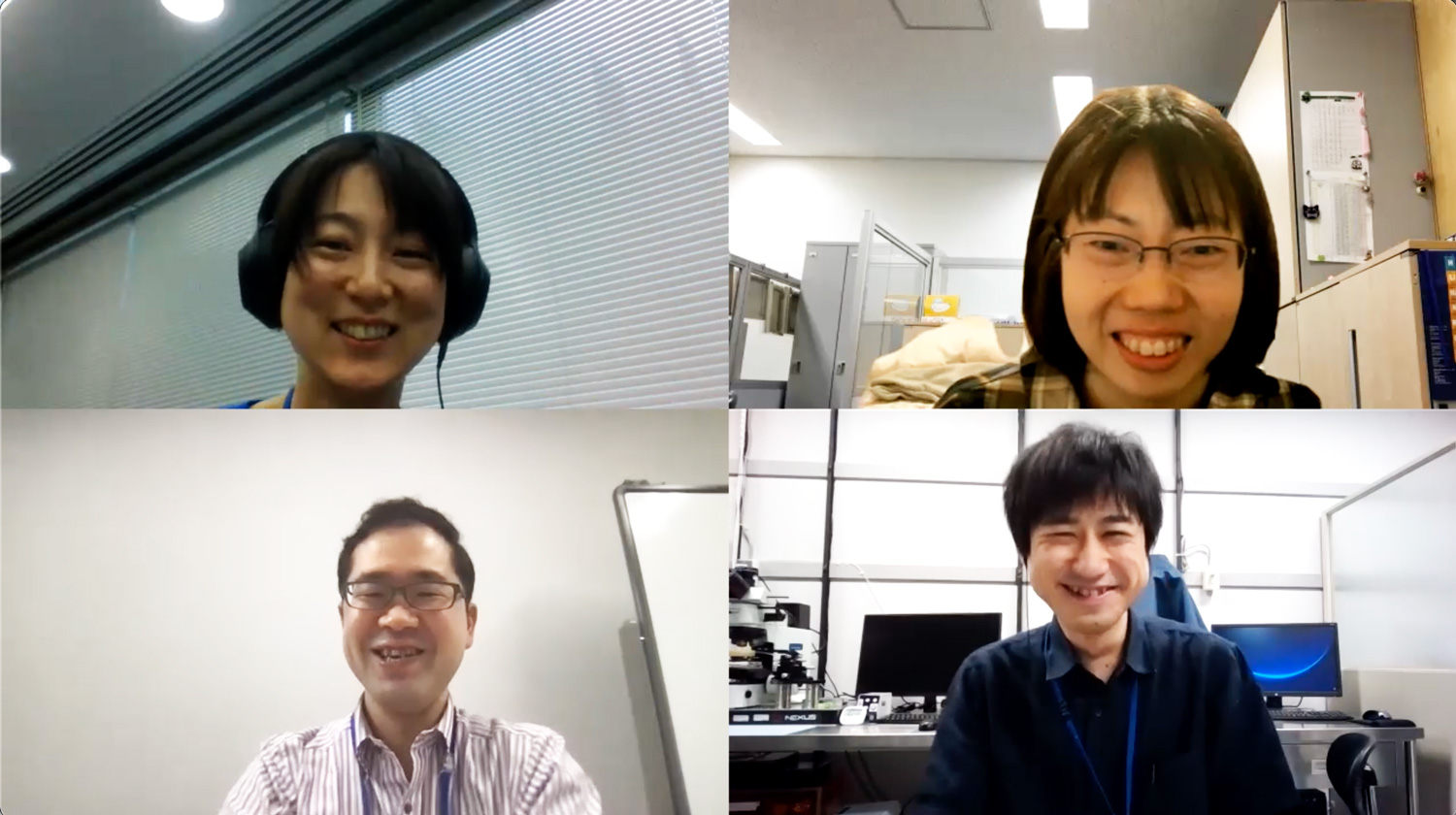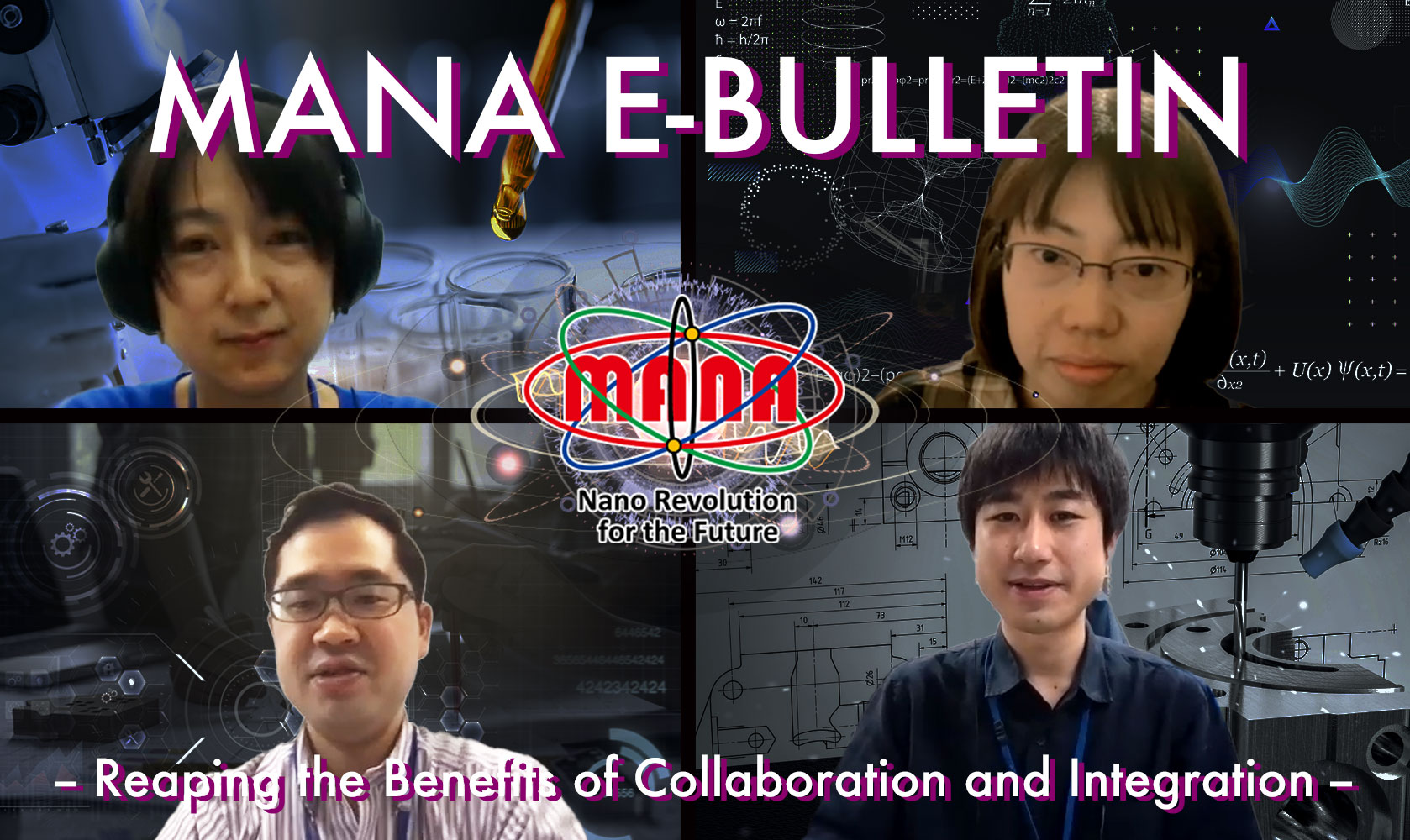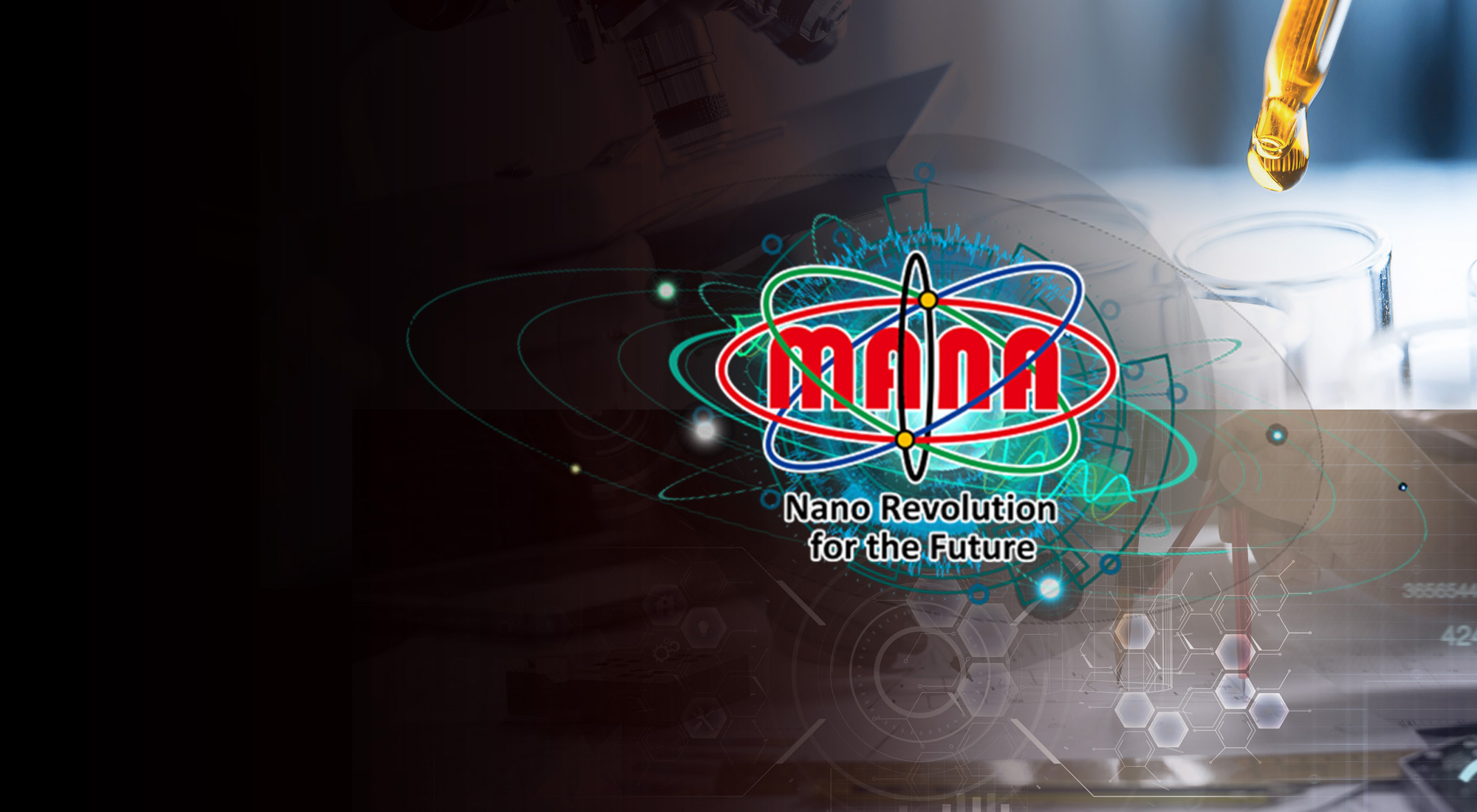An interview with four scientists involved with MANA’s programs to encourage interdisciplinary collaboration
Waka NAKANISHI
Principal Researcher, Molecular Design and Function Group, Research Center for Functional Materials
Ayako NAKATA
Senior Researcher, First-Principles Simulation Group
Toshikaze KARIYADO
Senior Researcher, Nano-System Theoretical Physics Group
Takuya IWASAKI
Independent Scientist, Quantum Device Engineering Group
MANA established in 2016 several special research programs, in the belief that “science can make strong advances through the integration of research”.
Four of the key researchers in these programs — Dr. Waka Nakanishi and Dr. Ayako Nakata in the Theory-Experiment Pairing Program (TEPP), and Dr. Toshikaze Kariyado and Dr. Takuya Iwasaki in the Challenging Research Program (CRP) — sat down with MANA e-Bulletin to discuss their work and their experience with these programs.
Forming Collaborations
− Let’s start with a description of your research.
Nakanishi: In organic chemistry, we create organic molecules in the desired form by connecting carbon atoms. Since their structure is directly related to their functions, I focus on realizing functions through designing molecules.
Nakata: I do theoretical research using first-principles calculations. Ideally, we can know the electronic state of a material from calculations. However, it’s difficult to simulate systems with many atoms, because it requires vast computational resources. Therefore, we developed a program called CONQUEST to determine the state of systems and molecules containing many atoms. We are now applying it to various real-life material systems.
Kariyado: My research is on clarifying the properties of materials using theory. There are many meanings to the term “properties of materials,” but I focus on how to control the electronic state in matter.
Iwasaki: I am interested in electron transport, which is the source of electric current, and my research aims to clarify the properties of materials. I am particularly interested in two-dimensional materials, mainly graphene. Ideally, graphene is flat, but if the substrate is uneven, it loses its exceptional properties. To solve this problem, we are developing a technique to superimpose graphene on a very flat 2D material.

− How did you start your collaboration?
Nakanishi: In organic chemistry, we often look at the function of a molecule as an “overall average” under easy-to-measure conditions, such as a large amount in a solution or organic solvent. Experiments that look at the shape and function of single molecules are still in their infancy.
In 2017 I participated in the Nanocar Race, an international competition to manipulate single molecules (nanocars) around a track. We were looking a theorist to investigate the function of our molecules, and Dr. Christian Joachim, a MANA satellite principal investigator and director of the Nanocar Race, introduced me to Dr. Nakata.
Nakata: Actually, the project here had three parts. The first was to calculate the behavior of a single molecule that was first designed. It didn’t move as expected, so we designed a new one. That in turn had some unexpected functions, so we applied to study them, and summarized our research in a paper.
Kariyado: In our case, we had originally been connected with separate research groups, but decided to deepen our collaboration.
In graphene research, there is a lot of interest in the effective mass, a measure of the mobility of electrons. The lower the effective mass, the easier electrons move, but graphene has zero effective mass, so it moves a little too much! We want to manipulate it and control it in a usable way, and we focus on stacking two sheets of graphene slightly out of alignment, which increases the effective mass.
Iwasaki: Creating new functions with graphene layers is now a worldwide trend. That wasn’t the aim of the experiment — it just happened by accident. Even before we started the project, we were wondering what the mechanism behind the emergent functions produced by superposition.
− What did you learn about communication between theorists and experimentalists?
Kariyado: In our case, our goals and backgrounds were similar, so the only difference between us was method — calculation or experiment. In graphene research, theory and experiment have always been close, and there is no difference in terminology or research direction.
Nakata: I mainly work on developing computational methods, and I haven’t done much applied calculation. Perhaps because of this, when I talked with Dr. Nakanishi, who is an experimentalist, at times I could not fully explain the calculations, or conversely, could not properly understand the experimental results. So it was difficult at first. But eventually, we were able to communicate smoothly.
Nakanishi: I respected and trusted Dr. Nakata as an expert, but as we were in different fields, I couldn't fully understand, so I listened to every detail. We had many hours of intense discussions.
− How did MANA’s environment help you in proposing research to TEPP and CRP?
Nakanishi: We rented a conference room and had a half day of discussions. MANA has a “melting pot” environment, and it’s easy to move around.
Nakata: When Dr. Joachim came to MANA, we often talked with him as well. Since the relationship between young and experienced researchers is not that of master and disciple, which is unique to Japan, the environment is very easy to talk to.
Kariyado: MANA’s system makes it easy to take on new challenges. In my proposal I talked about building on my existing work — this is normal. But I also added brand-new things, and made clear that although there was no guarantee of success, I wanted to try anyway.
Nakanishi: In a “Grant-in-Aid for Scientific Research” application, the standard way is to propose to do something as a next step, based on what you’ve already done. But in a MANA application, I feel like I’m being asked to draw up a dream of the future. This is rare in Japan. Writing about the future is American style, and it’s appreciated in MANA’s international environment.

Interdisciplinary Support
− What are your thoughts on MANA's support for interdisciplinary research?
Iwasaki: My research with Dr. Kariyado is progressing steadily, so I hope we can continue in the same way. I have no complaints about the research or the budget.
Nakanishi: I worked at MANA until 2018, then was transferred to another NIMS center. I joined this project because even after leaving MANA, I can still collaborate with people here. Many research funding systems approve research that is useful and contributes to society. But if you want to try something new or a fusion of things. I think MANA is a good place for that.
Iwasaki: This year, MANA added another research program, the Synthesis-Characterization Pairing Program. I’d like to see all kinds of collaborations. The program was set up based on MANA Director Taniguchi's own experience of collaborations, and I expect to see some very interesting research projects.
Nakata: Collaboration is important in research, and it’s important to think about who you can work with. Some of us at MANA have never met, and it would be nice to have more opportunities to get to know each other.
− What do you want to do in the future?
Nakanishi: Before working with Dr. Nakata, I didn't know about single-molecule design, but through TEPP, I was introduced to this field. I’ll continue my research with the single molecule perspective in mind.
Nakata: Working with experimentalists, I have found several gaps in my understanding and points for improvement, and I want to clear them up in my future research.
Kariyado: Theoretical research is all about explaining and predicting. I found interesting things in Dr. Iwasaki's experimental results from a theorist's point of view, and asked him to try the experiments. I was able to provide both explanations and predictions, which is a theorist’s job. I will continue to make it my goal to prove that theorists are still necessary!
Iwasaki: In the past, I often chose experimental 2D materials quite vaguely, using materials that happened to be on hand in the laboratory. In this project, Dr. Kariyado suggested materials that might be interesting. I hope we can continue this relationship and deepen our research together.
#####

Further information
Waka NAKANISHI, SAMURAI-NIMS Researchers Directory Service
Ayako NAKATA, SAMURAI-NIMS Researchers Directory Service
Toshikaze KARIYADO, SAMURAI-NIMS Researchers Directory Service

